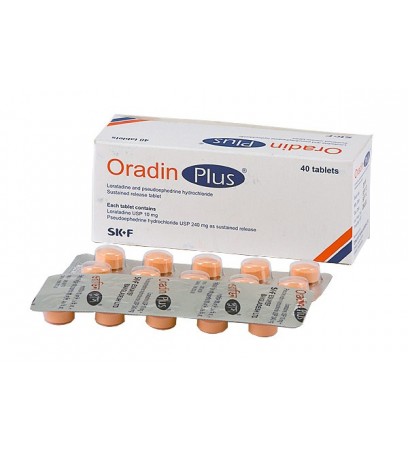Oradin Plus Tablet (Extended Release) 10 mg+240 mg
- Brand:Eskayef Pharmaceuticals Ltd
- Product Code: Loratadine + Pseudoephedrine
- Availability: In Stock
-
7.00Tk.
This product has a minimum quantity of 10
Indications
Loratadine & Pseudoephedrine tablet is indicated for the relief of symptoms of seasonal and perennial allergic rhinitis, temporarily relieves runny nose, sneezing, itching, watery eyes, nasal congestion, itching of the nose or throat due to allergic rhinitis or other upper respiratory allergies, symptoms of common cold, nasal congestion & sinus pressure associated with sinusitis.
Pharmacology
Loratadine is a non-sedative histamine H1-receptor antagonist with anti-allergic properties. Loratadine is a long acting tricyclic anti-histamine with selective peripheral H1-receptor antagonistic activity and no central sedative or anti-cholinergic effect.
Pseudoephedrine is an orally active sympathomimetic amine and exerts a decongestant action on the nasal mucosa. This is recognized as an effective agent for the relief of nasal congestion due to allergic rhinitis. It has nasal and bronchial decongestant activity.
Pseudoephedrine is both an α-and β-adrenergic receptor agonist. It causes vasoconstriction via direct stimulation of α-adrenergic receptors of the respiratory mucosa. It also directly stimulates β-adrenergic receptors causing bronchial relaxation, increased heart rate and contractility.
Pseudoephedrine is an orally active sympathomimetic amine and exerts a decongestant action on the nasal mucosa. This is recognized as an effective agent for the relief of nasal congestion due to allergic rhinitis. It has nasal and bronchial decongestant activity.
Pseudoephedrine is both an α-and β-adrenergic receptor agonist. It causes vasoconstriction via direct stimulation of α-adrenergic receptors of the respiratory mucosa. It also directly stimulates β-adrenergic receptors causing bronchial relaxation, increased heart rate and contractility.
Dosage
Adults and Children 12 years of age and over:
- Loratadine 5 mg and Pseudoephedrine 120 mg: One tablet twice a day (every 12 hours).
- Loratadine 10 mg and Pseudoephedrine 240 mg: One tablet once daily.
Administration
Loratadine & Pseudoephedrine tablet should be administered when both the antihistaminic properties of Loratadine and the nasal decongestant activity of Pseudoephedrine Sulfate are desired in patients 12 years of age and older.
Interaction
No specific interaction studies have been conducted with loratadine and pseudoephedrine sulfate extended release tablets. However, loratadine (10 mg once daily) has been safely coadministered with therapeutic doses of erythromycin, cimetidine, and Ketoconazole in controlled clinical pharmacology studies.
Loratadine and pseudoephedrine sulfate combination tablet is contraindicated in patients taking monoamine oxidase inhibitors and for 2 weeks after stopping use of an MAO inhibitor. The antihypertensive effects of beta- adrenergic blocking agents, methyldopa, reserpine and veratrum alkaloids may be reduced by sympathomimetics. Increased ectopic pacemaker activity can occur when Pseudoephedrine is used concomitantly with digitalis.
Loratadine and pseudoephedrine sulfate combination tablet is contraindicated in patients taking monoamine oxidase inhibitors and for 2 weeks after stopping use of an MAO inhibitor. The antihypertensive effects of beta- adrenergic blocking agents, methyldopa, reserpine and veratrum alkaloids may be reduced by sympathomimetics. Increased ectopic pacemaker activity can occur when Pseudoephedrine is used concomitantly with digitalis.
Contraindications
Loratadine & Pseudoephedrine tablet is contraindicated in patients who are hypersensitive to this medication or any of its ingredients. It is also contraindicated in patients with narrow-angle glaucoma or urinary retention, and in patients receiving monoamine oxidase (MAO) inhibitor therapy or within fourteen (14) days of stopping such treatment. It is also contraindicated in patients with severe hypertension, severe coronary artery disease, and in those who have shown hypersensitivity to its components, to adrenergic agents, or to other drugs of similar chemical structures.
Side Effects
In general loratadine and pseudoephedrine sulfate combination tablet is well tolerated. Clinical trial suggests a very low rate of adverse effects associated with its administration. Among the very few adverse effects, commonly reported are difficulty in sleeping, dry mouth, mild stomach upset, headache, nervousness, dizziness and loss of appetite or thirst. These effects subside as the body adjusts to this medication.

